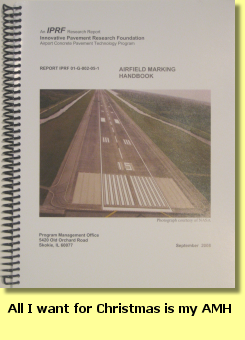 |
 |
Airfield Marking Handbook - Chapter 6By Mike Speidel
This piece is the fifth in a six article series summarizing each chapter contained within the Handbook. As the principal authors of the Airfield Marking Handbook, we will also be identifying key issues for your consideration.
Application Procedures This chapter in the AMH discusses the process of applying markings to an airfield pavement surface. The factors described relate directly to the application of markings by a contractor, airport personnel, or others. The material is of greatest benefit to design engineers, applicators, and project inspectors. 
Chapter 6 covers both the installation of new markings as well as maintaining existing markings. During our research, we found very little evidence of applicators monitoring material coverage rates. That was alarming because the marriage of binder and bead in proper proportions is essential to attain effective retroreflectivity. If waterborne paint is applied too thinly, the beads have nothing to anchor in, and will dislodge. If waterborne (Types 1 and 2) paints are applied to thickly, the binder will crack and lead to an ineffective marking. These material coverage rates are affected by several factors including equipment, the speed of application, the environment, etc. To ensure proper application, tools are used to measure material usage. A wet film thickness gauge and bead calibration bucket are used to target optimal coverage, uniform results, and effective retroreflectivity. Equipment is discussed at length identifying desirable marking systems to be used on airfields. Unlike highways, airport markings range from six inches to thirty-six inches wide, and in some cases measure thrity feet in width. Therefore, it is a best practice for truck mounted painting equipment to have the ability to paint six to thirty-six inches wide in one pass. For markings with black contrast, such as taxiway centerlines and edge lines, it is a best practice to paint the two colors simultaneously. Glass beads are to be applied automatically with dispensers mounted directly behind the paint guns in order to embed properly in the binder and maintain specified coverage rates. The successful application of airfield markings requires knowledge and experience in a wide range of areas, including standards, specifications, surface preparation, equipment, materials, procedures, and quality control. Each of these ares can have a significant impact on the overall quality of the final markings. Of all of the techniques used to prepare and apply markings, the best are those where close attention is paid to details, where data is recorded and documented, and where quality materials are used. Want a handbook? Check this out. If you'd like a free handbook, be sure to attend one of our Airfield Marking Symposiums in 2010; locations to be announced soon! |

 With the Airfield Marking Handbook hot off the presses and now being distributed to the industry, let's take a look at
what's inside. In each of the next several issues of Sightline's webletter, I'm going to take a look at each chapter and it's
highlights. It's the most comprehensive resource available dealing strictly with airfield markings. To obtain a copy,
With the Airfield Marking Handbook hot off the presses and now being distributed to the industry, let's take a look at
what's inside. In each of the next several issues of Sightline's webletter, I'm going to take a look at each chapter and it's
highlights. It's the most comprehensive resource available dealing strictly with airfield markings. To obtain a copy,